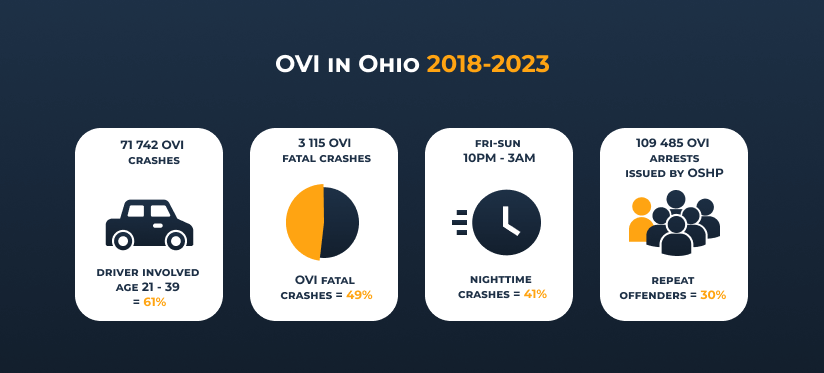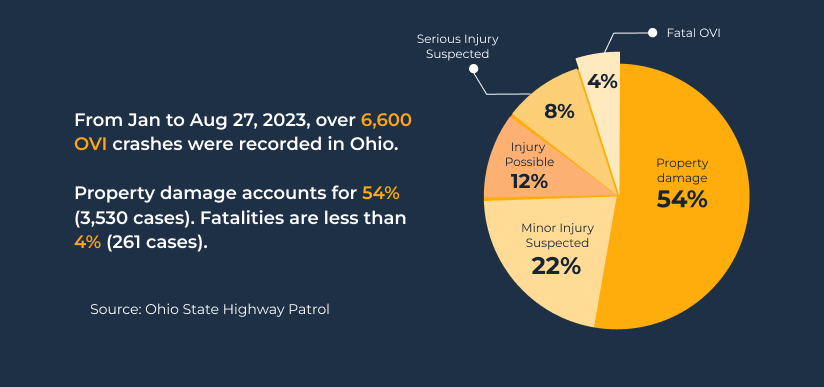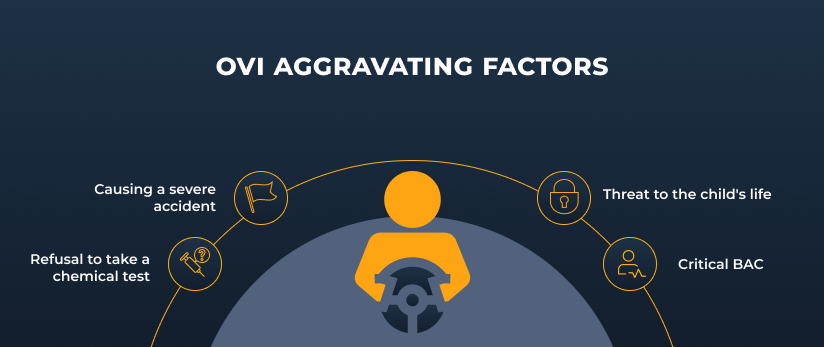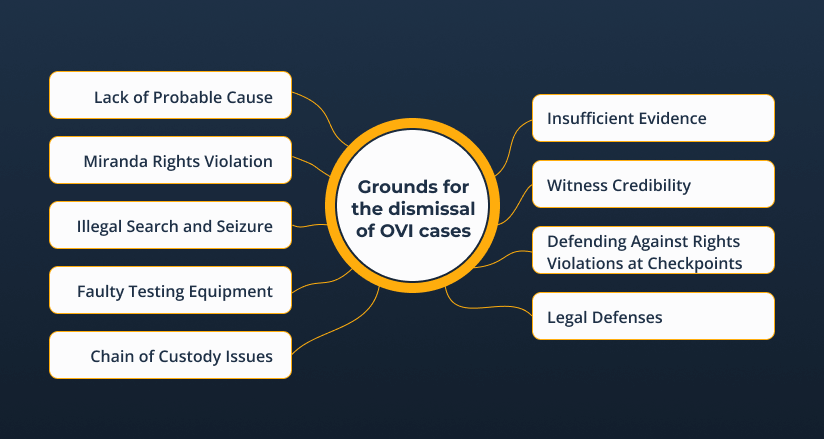
The Ohio State Highway Patrol recorded 71,742 OVI crashes from 2018 to August 2023. This trend highlights the significance of OVI charges in Ohio. Let’s look into the intricacies and understand what is OVI.

What does OVI stand for? Uncover OVI charge meaning to decode Ohio’s DUI-related terminology.
To start, let’s define what is OVI in police terms. OVI stands for Operating a Vehicle Impaired, which refers to the act of operating a transport while under the influence of alcohol, drugs, or a combination of both.
In essence, the OVI definition covers scenarios where a driver’s judgment, reflexes, and motor skills are impaired, potentially endangering themselves and others on the road.
In Ohio, OVI is the legal charge for operating any type of vehicle under the influence of alcohol or drugs.

Under Ohio law, the term “vehicle” encompasses a broad range of motorized and non-motorized transportation modes. This includes:
An individual operating any of the listed vehicles with a Blood Alcohol Concentration (BAC) exceeding 0.08 is subject to an OVI charge in Ohio. But, for individuals under the age of 21, Ohio imposes a lower legal limit of 0.02 BAC.
Now, let’s address a common question: How does OVI arrest meaning differ from DUI and other drunk driving charges in Ohio?
In Ohio, there is a difference between DUI and OVI, both of which pertain to impaired driving offenses:
In Ohio, laws define OVI with a broader range of behaviors than traditional driving. The adoption of the term OVI in 2005 represented a significant shift from previous terminology such as DUI and DWI. This change aimed to remove the requirement that the vehicle be motorized, recognizing that impairment can occur in various types of vehicles.
From a legal point of view, yes. OVI driving includes not only the operation of a motorized vehicle but also extends to the operation of any vehicle, streetcar, or trackless trolley while under the influence of alcohol or drugs. This means that individuals can face OVI charges even if they are not operating a motorized vehicle.
So, what sets DUI vs OVI in Ohio? The key distinction lies in the terminology used within the state’s legal code. While many states continue to use DUI, Ohio officially employs OVI, which encompasses a broader range of vehicles and situations where impairment is a factor.

Check out our article “Is Blackmail Illegal? A Comprehensive Guide to its Legal Implications“
We’ve figured out what DUI is. To truly grasp these differences, we need to explore the meanings of DWI, OWI, DWAI, and OMVI.

Let’s explain what each of these acronyms stands for:
In essence, the difference between these terms lies in where they are used and what they refer to in terms of influence and vehicles. If you encounter such a situation, it’s advisable to reach out to a skilled DUI lawyer for personalized guidance.
Now let’s move on to the question of what is OVI charge penalty.
According to Section 4511.19 of the Ohio Revised Code, OVI can be either a felony or a misdemeanor, depending on the specific circumstances of the offense and any prior convictions.
Here’s a breakdown of how OVI offenses are classified:
Felony OVI charges can also arise from certain aggravating factors:

Also, conviction of OVI with a high blood alcohol concentration (BAC) can result in additional penalties. Ohio’s “high BAC” threshold stands at 0.17% BAC or above. And, in case of a severe accident, emotional distress can factor into legal proceedings if it’s proven that an impaired driver’s actions caused emotional harm to others involved.
Penalties for OVI in Ohio can vary depending on several factors:
Below are the general penalties associated with OVI offenses in Ohio.
1st Offense
2nd Offense (within 10 years of the first offense)
3rd Offense (within 10 years of the second offense)
4th Offense or More (within 10 years of the third offense)
Possible alternative sentencing options include house arrest with electronic monitoring, continuous alcohol monitoring, or both.

Read also about “What Proof Do You Need for a Restraining Order? A Quick Guide“
Let’s reinforce the knowledge of whats an OVI with potential reasons for closing an OVI case and defense tactics.

Here are some common grounds for the dismissal of OVI cases:
Remember, under the Ohio Revised Code, the arresting officer must provide written advice containing specific information:
Keep in mind that anyone facing an OVI offense has the Constitutional right to defend themselves against the charges.
Now you know the main aspects of what is OVI. So, can you beat an OVI case in Ohio? Yes, It’s essential to consult with an OVI attorney to evaluate your case’s specific circumstances, identify potential grounds for dismissal, and build a strong defense in court. Contact us to find a recommendation of defense lawyers in the shortest terms.
Yes, Ohio mandates a 10-day consecutive jail term, unless alternative penalties like house arrest with electronic monitoring or continuous alcohol monitoring are imposed.
Yes, in Ohio, a guilty verdict for causing an accident can result in a license suspension. For a first-time offense, the suspension can last up to 1 year, and for multiple offenses (with no more than a 10-year gap between each), it can lead to a 3 years suspension, up to life.
Fines range from $375 to $10,500, depending on the severity and recurrence of the OVI crime.
A first OVI in Ohio adds 6 points to your driving record, and each subsequent violation incurs an additional 6 points. You can also get extra points for aggravating circumstances. Your record clears points after a two-year period.
Ohio regards OVI as a prior offense after 10 years, but the record of the offense remains forever.










